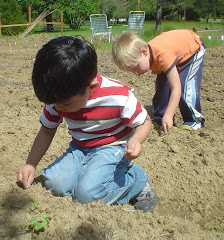(To read a compilation of all our potato blogs, go to:
Can I plant potatoes from the grocery store? and
Can I plant potatoes from the grocery store? and
Some people who are following this blog have been "chitting" potatoes to increase their storage of solar energy and make their sprouts tougher prior to planting. This post covers how to plant your potatoes. If you've got some potatoes that are eager to get in the ground, here's a simple method that yields good results. (As with all gardening techniques, there are about as many ways to plant potatoes as there are potato varieties - and that's a lot! What follows is just one way that we've found works well for us. Feel free to add comments to our web-page with your own best tips and methods.)
Potato leaves emerging from the soil
Begin by roto-tilling the soil, or loosening it up so the potatoes have light, loose soil to form in. If the ground is too firmly packed, your potatoes will tend to be smaller. If you're planting more than one row, stake the rows about 36" apart. We use wooden stakes at the end of each row and baling twine we've recycled and tied together to form a long string. This will help you plant straight rows.
Baling twine saved from hay-bales, tied together for re-use in the garden
Using a clam-shell post-hole digger, dig your holes about 8"-10" apart and about 10" deep. You have to wait until your soil is drained enough so the fence-post digger doesn't get caked up with mud. If you just can't wait, and the mud is a problem, try filling a 5-gallon bucket with water and dipping the clam-shells in it between holes. This should help keep the mud from building up.
Digging holes with a clam-shell post-hole digger
Put some fertilizer in each hole - about 2 heaping tablespoons ( a small handful). We use an all-purpose, organic mix that we get from a local supplier called "Down to Earth" in Eugene. It's OK to put it straight in the hole. It won't "burn" the potato plants. You can use a big handful of worm-compost instead of fertilizer, if you have some. It helps if you're systematic: first dig all your holes, then fertilize, then plant them all. This gives you economy of motion and, if the holes are all prepared, your potatoes won't be shocked through excessive exposure to sun and air.
Worm compost to fertilize the growing potatoes
This year we chitted potatoes in March and April, and then layered them in leaves so they didn't become dehydrated before we put them in the ground. Because we've had such a wet spring and we've had to wait so long, many of the potatoes had begun to send out long shoots and tiny rootlets. While it is important to expose potatoes to the sun when you first chit them, that same exposure can be devastating if they have begun to form fine root-hairs. If they get dried out from direct exposure to sun and air, at this stage, it can set them back considerably from their ability to produce potatoes. Very carefully tease the potatoes out of the leaf or straw mulch you've stored them in. The ideal time to plant your potatoes is before they've grown fragile stems and rootlets but, if nature hasn't been cooperating and they've grown too far, just be very gentle. Don't get too far ahead of yourself. Only tease out as many potatoes as you have dug holes for. Don't leave any exposed to the sun or air. Cover them if you must attend to something else for awhile. Place a seed-potato in each hole.
Note the long sprouts and fragile, skinny root-hairs
The next step is to cover and mound the potatoes. Using a flat rake, gently pull the soil back over the hole and build it up into a raised bed at least 6" above the path and a foot or so wide. This will give you foot-wide paths for mulching. The advantage of raised beds is that they are able to catch more sun, the soil heats up and drains better and plant-growth is increased.
Heavily mulching the paths feeds the soil, keeps moisture in the ground and prevents weeds from growing.
Lastly, lay down a nice, thick layer (about 6") of mulch in the paths. You can use last year's leaves (no walnut please--they're toxic to plants), or straw, or spoiled hay. For more about the heavy-mulch method that we use for gardening, you'll just have to wait till we have time to write that post! If the potato leaves poke through the ground before the risk of frost has passed in your area, be sure to loosely cover them with these mulch materials on cold nights. Potatoes are very sensitive to frost. There's not a whole lot more to do with potatoes until harvest time. If you notice the forming potatoes pushing up out of the soil, be sure to cover them with more soil or mulch to keep them from turning green (green potatoes are poisonous).
Anticipate the harvest!












































No comments:
Post a Comment